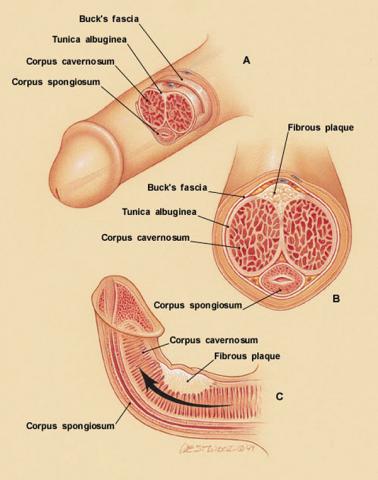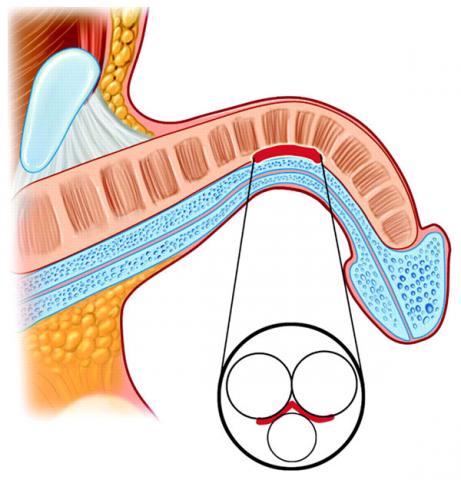What is Peyronie’s Disease?

Credit: www.aafp.org
Peyronie’s disease (PD) is a condition in which an inelastic scar (or plaque) grows within the tunica albuginea – the outer layer of the tubes that support the erection within the penis. Whilst in can occur at any age, it is more common in men older than 50 years.
It has been quoted as affecting up to 9% of men. It occurs even more frequently in men who have under gone radical prostatectomy for the treatment of prostate cancer.
What causes Peyronie’s Disease?

The exact cause of Peyronie’s Disease is not known, nor is the trigger that initiates the development of plaque growth. There does seem to be some genetic susceptibility, as it does seem to run in families, and men with PD are also more likely to develop Dupuytren’s contracture – a condition where plaques develop on the tendons of the hand causing the fingers to curl (as can be seen with the actor Bill Nighy).
There is a theory that the scar forms after defective healing following multiple episodes of “micro-trauma” to the erect penis. It does occasionally occur after direct more major trauma to the erect penis.
What are the symptoms of Peyronie’s Disease?
Peyronie’s disease often seems to appear over a short duration of time. It may present with any and all of the following:
-
Pain in the penis – usually only early in the disease and only when the penis is erect.
-
A bend (curvature) in the erect penis. Whilst it can bend in any direction, the most common is for the penis to point towards the nose.
-
Shortening of the penis.
-
A palpable plaque (a lump you can feel) in the penis.
-
Erectile dysfunction.
-
Depression or anxiety – many men find this disease most distressing and it affects their mood and general approach to life. You should let your doctor know if you are feeling this way.
What tests are needed?
A diagnosis of Peyronie’s Disease is usually possible after a history is obtained from the affected man. It is often beneficial to bring a picture of the erect penis, showing the bend from two different directions.
The doctor may also ask you to have:
-
Penile ultrasound to demonstrate the plaque and make sure there are problems within the penis.
-
Doppler studies – you will be given an injection to give you an erection and the blood flow of the penile vessels will be examined.
How is it treated?
There are a number of treatment options available for Peyronie’s disease though the success rates are quite variable.
Non-Surgical Options
Oral Medication
Oral medication is convenient, but only has limited success rates (50% at best). Medication includes: Pentoxyfylline, Colchicine, PDE5 inhibitors (Viagra style drugs).
Topical Medication
Compounding chemists can formulate a 15% Verapamil gel or ointment that can be applied to the shaft of the penis (transdermal application). There is some data suggesting a benefit to men suffering from Peyronie’s disease. It can do no harm.
Penile Stretching
There is some evidence that regular penile stretching that is performed over 6-12 weeks can improve the penile curvature. Devices are available to help with this technique.
Low Intensity Shock Wave Therapy
There have been some early studies suggesting this treatment is beneficial in Peyronie’s disease (as it is with erectile dysfunction). Whilst long-term evidence is not available, it is a painless outpatient therapy that can do no harm and potentially improve the PD.
Injections
A number of drugs that are injected directly into the plaque have been demonstrated to benefit some men. These drugs include: Verapamil, Collagenase and alpha- interferon.
Surgical Options
There are a number of surgical options available.
Plication
This is usually a day procedure in which sutures are placed along the inside of the penis on the opposite side to the bend – straightening the penis. Often referred to as a Nesbitt’s plication or procedure.
Plaque Incision & Grafting
This is more complex surgery and usually reserved for men with very severe curvatures or a short penis. The procedure involves lifting the nerves of the penis to allow access to the plaque, which is then incised, and a special graft material sutured into place to straighten the penis. It has a risk of secondary erectile dysfunction over the subsequent two years.
Penile Prosthesis
In many men insertion of a penile prosthesis (implant is the best option – especially if they also have some erectile dysfunction, softness at the head of the penis or “waisting”. The penile prosthesis not only straightens the penis but also provides a strong and reliable erection.
